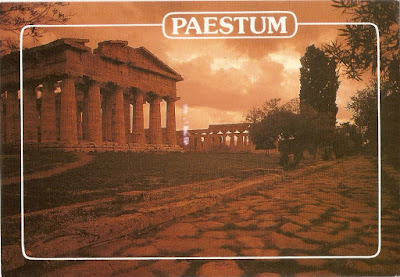The Churches and Convents of Goa are a group of Catholic religious buildings that have been influential for spreading both the faith and their Portuguese style of art and architecture around Asia. They are located in Old Goa, which from 1565 was the capital of the Portuguese Indies. It was abandoned as such in 1760 because of a malaria outbreak.
Wednesday, October 19, 2011
India : TAJ MAHAL
Taj Mahal is the finest example of Mughal architecture, a style that combines elements from Persian, Turkish and Indian architectural styles.
Friday, October 14, 2011
UNESCO WHS Postcard : Paestum
Paestum is the classical Roman name of a major Graeco-Roman city in the Campania region of Italy. It is located in the north of Cilento, near the coast about 85 km SE of Naples in the province of Salerno, and belongs to the commune of Capaccio, officially also named Capaccio-Paestum.
UNESCO WHS Stamps from Italy
Orto botanico di Padova :
The Orto Botanico di Padova is a botanical garden in Padua, northern Italy. Founded in 1545, it is the world's oldest academic botanical garden that is still in its original location The garden, affiliated with the University of Padua, currently covers roughly 22,000 square meters, and is known for its special collections and historical design.Hadrian's Villa :
The Hadrian's Villa (Villa Adriana in Italian) is a large Roman archaeological complex at Tivoli, Italy.
The villa was constructed at Tibur (modern-day Tivoli) as a retreat from Rome for Roman Emperor Hadrian during the second and third decades of the 2nd century AD. Hadrian was said to dislike the palace on the Palatine Hill in Rome, leading to the construction of the retreat. During the later years of his reign, he actually governed the empire from the villa. A large court therefore lived there permanently. The postal service kept it in contact with Rome 18 miles (29 km) away.
After Hadrian, the villa was used by his various successors. During the decline of the Roman Empire the villa fell into disuse and was partially ruined. In the 16th century Cardinal Ippolito II d'Este had much of the marble and statues in Hadrian's villa removed to decorate his own Villa d'Este located nearby.
The villa was constructed at Tibur (modern-day Tivoli) as a retreat from Rome for Roman Emperor Hadrian during the second and third decades of the 2nd century AD. Hadrian was said to dislike the palace on the Palatine Hill in Rome, leading to the construction of the retreat. During the later years of his reign, he actually governed the empire from the villa. A large court therefore lived there permanently. The postal service kept it in contact with Rome 18 miles (29 km) away.
After Hadrian, the villa was used by his various successors. During the decline of the Roman Empire the villa fell into disuse and was partially ruined. In the 16th century Cardinal Ippolito II d'Este had much of the marble and statues in Hadrian's villa removed to decorate his own Villa d'Este located nearby.
Wednesday, October 12, 2011
Forbidden City
The Forbidden City was the Chinese imperial palace from the Ming Dynasty to the end of the Qing Dynasty. It is located in the middle of Beijing, China, and now houses the Palace Museum. For almost 500 years, it served as the home of emperors and their households, as well as the ceremonial and political center of Chinese government.
Subscribe to:
Posts (Atom)







